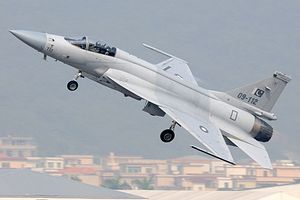The Pakistan Air Force’s (PAF) Aeronautical Complex/Chengdu Aerospace Corporation (PAC/CAC) JF-17 “Thunder” multirole fighter jet is reportedly slated to be upgraded with a Chinese-made active electronically scanned array (AESA) radar system improving the aircraft’s combat capability, according to Chinese media reports.
Hu Mingchun, head of the Nanjing Research Institute of Electronics Technology (NRIET), was quoted by the state-owned China Daily as saying that the KLJ-7A AESA radar system will substantially boost the JF-17s combat power.
“Our product will tremendously extend the fighter jet’s detection range, giving it a much longer sight that will help it detect the enemy’s aircraft before they do, and this is very important because in real combat if you see first, you fire first,” Hu said. “The radar is capable of tracking dozens of targets and engaging several of them simultaneously. It also has a good jamming-resistant capacity that keeps the plane away from enemy’s electronic interference.”
JF-17 production has been split into three production blocks: Block I, Block II, and Block III. Block I and II aircraft fly with the NRIET’s older KLJ-7 X-band fire control radar. JF-17 Block III aircraft will not only feature the new AESA radar system but also be fitted with a new electronic warfare system and an improved avionics suite overall.
“A selected number of Block II and the future Block III variants also feature an in-flight refueling (IFR) probe, which suggests that the aircraft could be deployed for longer-range maritime strike missions,” I reported last month. “The PAF and Navy have recently conducted a live-fire exercise, which included the launch of an anti-ship missile from a JF-17.”
PAC has so far rolled out 50 Block I aircraft and 50 Block II JF-17s. An additional 12 Block II aircraft are expected to be handed over to the PAF by the end of 2018. PAC has an annual domestic production capability of 25 JF-17 aircraft. Following the completion of Block II production, PAC will switch to Block III production. A two-seat trainer variant of the JF-17, designated JF-17B, will purportedly serve as the the basis for the JF-17 Block III version of the aircraft.
All JF-17 variants are powered by a Chinese license-built Klimov RD-93 (an RD-33 derivative) turbofan engine. The jet fighter is a multirole combat aircraft and can alternatively be armed with air-to-air, air-to-surface, and anti-ship missiles. The aircraft was specifically designed to replace PAF Mirage III/5 fighter jets. Overall, the PAF is looking to replace 190 aircraft, including all of its Chengdu F-7 and Dassault Mirage III/5 fighter jets by the end of the decade. PAF will also likely acquire additional F-16 Block-30 fighter aircraft.
































